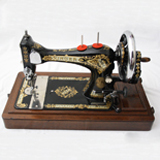Other Sewing Machine Manufacturers
While Singer is the main focus of this website, many other companies also played important roles in the development of domestic, industrial and miniature sewing machines. This section brings together those non-Singer manufacturers and their machines, showing how they developed alongside, and sometimes in competition with, Singer.
Here are two main areas of interest: full-size machines built by other manufacturers, and the intriguing world of toy and miniature models. Together they offer a broader view of the ingenuity, competition and craftsmanship that shaped sewing machine history throughout the 19th and 20th centuries.
-
Antique & Vintage Machines (Full-Size Models)
Explore non-Singer antique and vintage sewing machines produced by British, European and American makers. These pages examine their mechanisms, design features and production histories, and highlight notable surviving examples. -
Toy & Miniature Sewing Machines
Discover toy and miniature machines that introduced children and beginners to sewing. From early German toys to British, Japanese and American miniatures, this section includes Singer 20-style toys, their many clones and rare, highly collectable models.
Antique & Vintage Machines
The Antique & Vintage Machines section focuses on full-size, non-Singer models. Many were produced by manufacturers that once competed directly with Singer; others were smaller firms with distinctive designs and limited production runs.
Taken together, these machines illustrate how quickly sewing technology developed once the basic principles were established. Different makers experimented with drive systems, shuttle designs, tension arrangements and styling, and in doing so helped to shape the machines recognised today.
Toy & Miniature Sewing Machines
The Toy & Miniature Sewing Machines section looks at the smaller end of the market. Although often marketed as playthings, many toy and miniature machines are capable of producing a genuine line of stitching and reflect real engineering decisions made by their manufacturers.
This area covers early German examples, British Singer 20-style toys and their clones, Japanese and American miniatures and a number of scarce models that are now highly prized by specialist collectors. They provide useful insight into how sewing was introduced to younger users and how enthusiasm for the craft extended beyond full-size machines.
Exploring the Wider Sewing Machine Story
Together, these two subsections provide a wider context for Singer’s own development, showing how other makers responded to changing fashions, technologies and markets. They reveal the diversity of approaches taken to what was, fundamentally, the same basic task, producing a neat, reliable line of stitches.
As with other parts of this website, this section will continue to grow as further machines are researched and documented. If readers have information, photographs or insights about non-Singer makers or unusual models, contributions are very welcome and can help build a clearer picture of the sewing machine industry as a whole.
